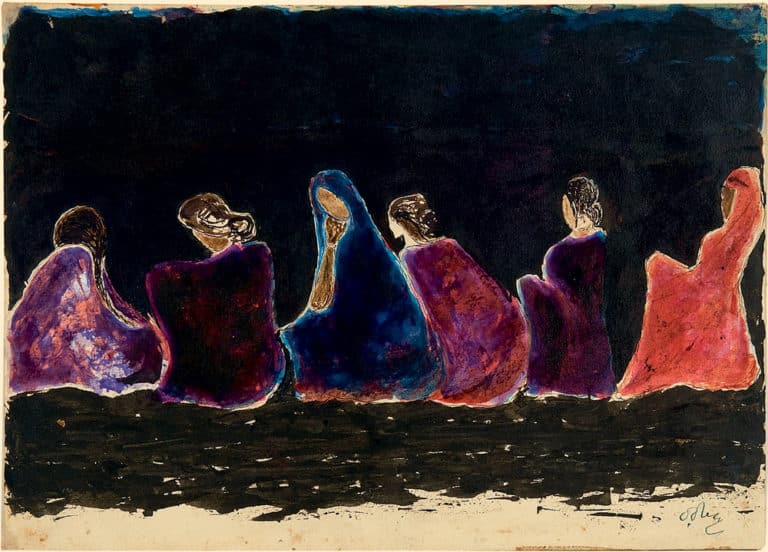
Rabindranath Tagore is widely celebrated for his literary genius, having won the Nobel Prize in Literature in 1913. However, his contributions as a visual artist are just as impactful. Tagore’s artworks and pioneering exhibitions were instrumental in shifting the perception of Eastern art in the Western world. His work went beyond poetry and music, embracing painting and drawing, and ultimately played a crucial role in introducing Eastern philosophy and aesthetics to a global audience.
Tagore’s artistic endeavors offered a new, intimate view of the East that contradicted Western stereotypes. Through his art, he conveyed the depth, complexity, and spirituality of Indian culture, influencing how the West engaged with Indian and Eastern art forms.
Tagore’s Artistic Journey: Beyond Literature
Rabindranath Tagore was not just a poet, but also a passionate visual artist. His artistic journey began in his later years when he started experimenting with watercolors, sketches, and paintings. Tagore was primarily self-taught, which gave his artwork a raw, unrefined quality, yet his style was innovative and deeply emotional. Over time, his works moved beyond mere representation to explore abstract themes and symbolic imagery, reflecting the spiritual essence of India and his personal worldview.
Unlike the rigid, academic styles that dominated European art at the time, Tagore’s art was free-flowing, spontaneous, and often inspired by his philosophical inquiries into self, nature, and spirituality. Tagore’s artistic experimentation was deeply connected to his literary work—where themes of humanism, divinity, and Indian culture were explored. It was this fusion of his literary genius with visual creativity that made him a truly Renaissance figure in the Indian subcontinent.
Tagore’s First Exhibition in the West: Redefining the East
Rabindranath Tagore’s first major exhibition in the West was in London in 1913, the same year he was awarded the Nobel Prize. This exhibition, which displayed his artworks alongside his literary work, was a defining moment in cultural exchange between the East and the West. His exhibition at the **London’s Grafton Gallery in 1913 was met with both intrigue and awe. Tagore’s works were seen as bold, mystical, and emotionally charged—a departure from the Western artistic conventions of the time.
The reception of his art in the West was groundbreaking because it contradicted the preconceived notions many Europeans held about the East. Rather than being “primitive” or “exotic,” Tagore’s work was seen as sophisticated, intellectually profound, and philosophically rich. His paintings were perceived as spiritual, offering an intimate and complex perspective on the Eastern way of thinking and being.
Tagore’s Abstract Art: A Challenge to Western Artistic Norms
One of the most significant contributions Tagore made to the Western art world was his rejection of traditional European realism. His art was a breakaway from perspective-based realism and focused more on symbolism, emotion, and inner experiences. Tagore’s works did not attempt to mimic the external world in precise detail but aimed to evoke universal themes of human existence, spirituality, and nature.
This focus on the abstract and symbolic was at odds with the dominant artistic traditions of the time, such as Impressionism or Realism. However, Tagore’s approach to art was in alignment with some of the modernist movements that were emerging in Europe. His paintings, with their fluid lines and evocative colors, found kinship with European artists like Wassily Kandinsky and Paul Klee, who were also exploring abstract forms and moving away from representational art.
In many ways, Tagore’s art helped bridge a gap between Eastern spirituality and Western modernism, showing that both traditions were capable of exploring universal truths in unique, non-literal ways.
A Deep Connection with Indian Spirituality
One of the defining features of Tagore’s art was its connection to Indian spirituality and philosophy. For Tagore, art was not just an aesthetic pursuit but a deeply spiritual practice. His works often depicted divine figures, sacred symbols, and natural elements, all of which were infused with the spiritual essence of India’s ancient traditions.
This aspect of Tagore’s art gave the West a glimpse into the mysticism and spiritual depth of Eastern culture. His paintings helped audiences in Europe and America see beyond the orientalist clichés of India and its people, offering a more authentic, introspective representation of Indian culture and philosophy. Tagore’s ability to integrate Indian spirituality with his artistic expression made him an invaluable figure in reshaping the West’s understanding of the East.
Tagore’s Global Influence on Art and Culture
Rabindranath Tagore’s art continued to influence the West long after his initial exhibitions. His paintings were not only celebrated for their aesthetic qualities but also for their philosophical depth, which resonated with thinkers, artists, and intellectuals in Europe and the United States.
Notable figures who admired Tagore’s art included Ernst Ludwig Kirchner, the German expressionist painter, and Albert Einstein, who corresponded with Tagore about the intersections of science, philosophy, and spirituality. Tagore’s ideas on humanism, spirituality, and the interconnectedness of cultures influenced both the literary and artistic worlds. His art, as much as his poetry, conveyed a universal message that transcended cultural boundaries.
Through his art and literary work, Tagore changed perceptions of India in the West, shifting the focus from colonial narratives to the recognition of India’s profound cultural richness, artistic sophistication, and spiritual wisdom.